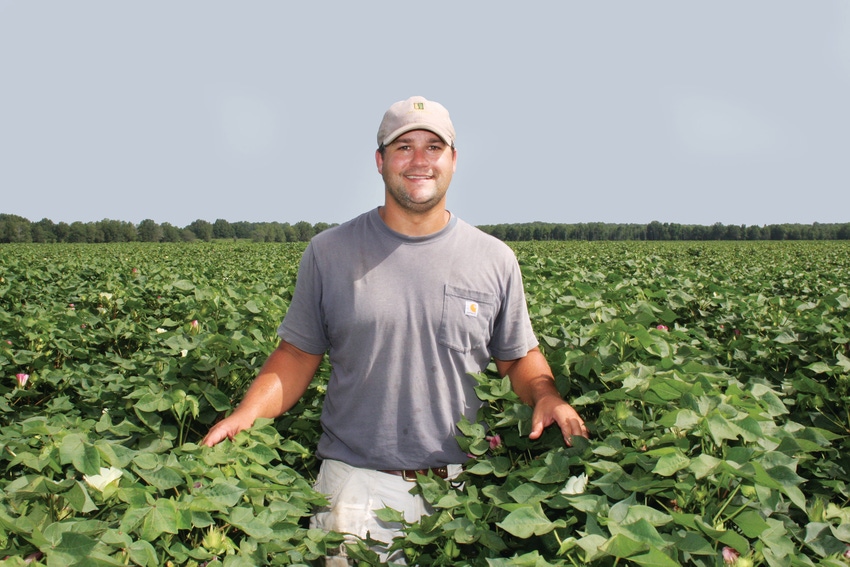
“If the apocalypse occurred, and all the oceans, lakes, and rivers in the world dried up, I believe Holly Bluff would still flood,” says Mississippi cotton grower Ron Goodman, for whom flooding is always a potential problem.
“Everywhere you farm around here, you’re probably touching a wildlife refuge like the Delta National Forest, and you’re pretty close to some sort of waterway, whether it’s the Sunflower River, Yazoo River, Lake George, Silver Creek, or canals,” he says. “It’s a wild host buffet for insects and weeds, because floods bring in a whole new seed bank of weeds like pigweed.”
So, he emphasizes drainage, keeping all exterior drainage ditches dug out and clean, and culverts open. “Without exterior drainage, you can’t do anything with interior drainage,” Goodman says. “You’ve got to have somewhere for that water to go. We also run water furrows, using a 4-wheeler with steel wheels.”
Even so, he can still lose a crop to flooding, as he did in 2017, when he lost half of a 570-acre block of corn that was tasseling in June.
Goodman requires a cotton variety that not only yields and grades well, but also provides technology traits that help him control worms and weeds — a variety like DP 1845 B3XF.
A participant in the Deltapine New Product Evaluator (NPE) Program for four years, he tried the new Bollgard III XtendFlex cotton on a 15-acre test plot in 2017. He liked what he saw, and planted it commercially this season. He planted 280 acres of DP 1845 B3XF this year, and the rest of his cotton acreage to DP 1646 B2XF — his standby variety.
“I enjoy participating in the NPE program,” he says, “because I can evaluate new varieties on my farm with my practices and soil types, which are all over the board. Most go from a Dundee-type sand, to a couple hundred yards across the field and you might be in Sharkey Clay. Soil variability is why DP 1646 B2XF has been so important in our area — because we can get the necessary stalk size. That variety grows well on any type of ground.”
In addition to considering a variety’s yield potential, Goodman looks closely at its fiber package. “DP 1646 B2XF has been getting 3 cents to 5 cents extra on grades,” he says. “Last year, out of the four varieties that I grew in test plots, DP 1845 B3XF was right up there with DP 1646 B2XF in yield and grade.”
Plus, he says, the Bollgard III variety gives him added bollworm protection. Bollworm pressure was high and extended this year, with egg lays starting at the end of June, and worms were still present in mid-August.
“I made a Prevathon application July 4 for bollworms, which were thick in a 570-acre block of DP 1646 B2XF and DP 1845 B3XF,” Goodman says. “I was already spraying DP 1646 B2XF, so I went ahead and sprayed DP 1845 B3XF in the same block. I probably didn’t really need to, but it gave us the opportunity to compare the residual control of the two technologies. The Bollgard III worm control, compared to Bollgard II, has been outstanding. Bollworms later came back on DP 1646 B2XF, and we had to spray Ammo. Later, in early August, we applied another Prevathon shot, but not on DP 1845 B3XF.
“Worms have to eat some of the Bollgard II fruit to ingest the toxin, but with Bollgard III, they can eat just part of the bloom flower, and they never make it to the boll. I found holes in the blooms, but not the bolls. All area cotton had bollworm pressure and bollworm damage, but you had to look hard to find bollworm damage in DP 1845 B3XF.”
The South Delta grower is also impressed with DP 1845 B3XF’s weed control, spraying XtendiMax herbicide with VaporGrip Technology as part of the Roundup Ready Xtend Crop System.
“I don’t know if I’d want to farm cotton without dicamba,” Goodman says. “The Yazoo River is about five miles from here; it backs up, and Lake George floods and spreads new weed seed across our fields. XtendiMax is a lifesaver for controlling pigweed and other weeds.
“VaporGrip Technology makes a difference. The dicamba formulation that we use is safe, and I haven’t seen any drift issues. I recently was spot spraying some pigweed and found a nest of baby birds in the top of a cotton plant, healthy as could be. That shows the safety of our crop protection materials.”
Goodman’s Deltapine representative, Scott Rebsamen, says, “DP 1845 B3XF is a very promising Bollgard III variety. The results from last year’s trials indicate that it has very high yield potential and very good fiber quality. We’re very excited about it, and look forward to seeing how it performs in 2018. We anticipate having increased demand for DP 1845 B3XF in 2019.”
Another thing that Goodman likes about DP 1845 B3XF is its response to plant growth regulators. “PGRs have become as important as bollworm protection,” he says. “If you don’t make timely applications, it could make a one bale difference. Our new varieties are racehorses, and you’ve got to stay on them to keep them fruiting. But DP 1845 B3XF is a variety that’s not going to get away from you; it’s much easier to control with PGRs than DP 1646 B2XF.”
Goodman gins his cotton at Silver Creek Gin at Holly Bluff; the gin processes anywhere from 50,000 to 100,000 bales per season. In a good year, the area will average 1,200 to 1,400 pounds per acre. “We need the yield because we spray a lot around here,” he says. “Our consultant, Jason Grafton, stays busy and we keep sprayers running regularly.”
All the surrounding woods and waterways supply plenty of worms and weeds. And water.
About the Author(s)
You May Also Like




